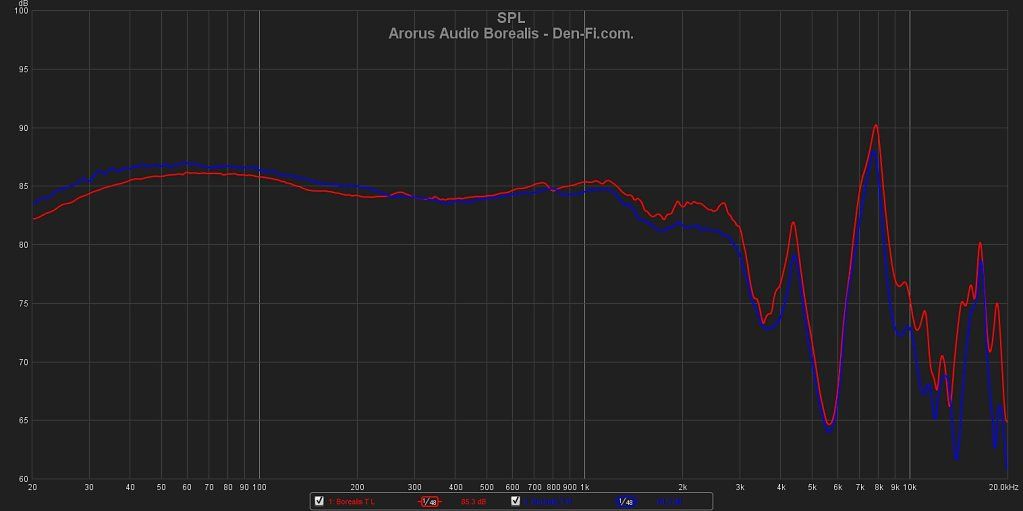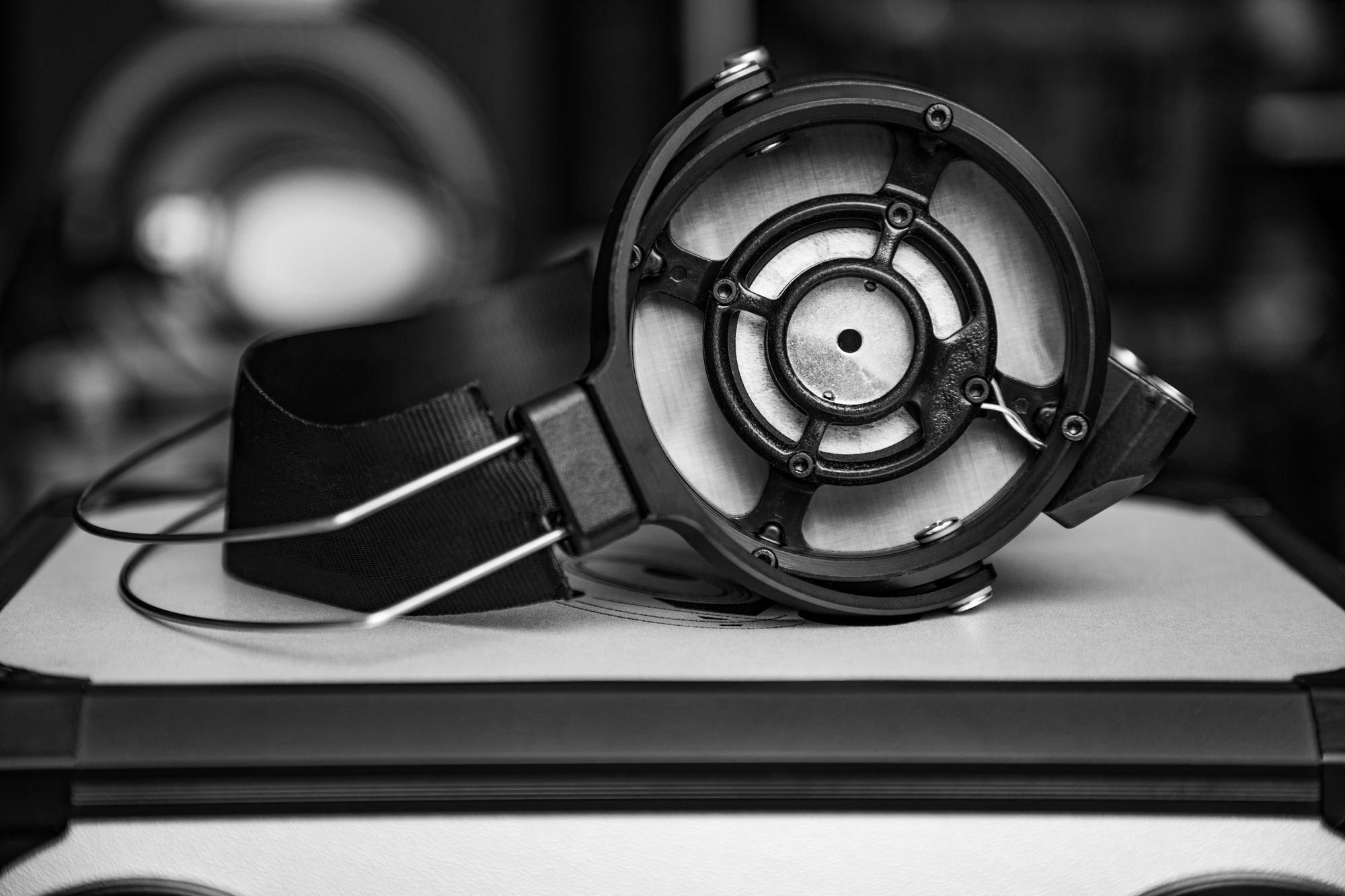
I will start out by noting that my Borealis is a relatively final demo unit. Things in place here may change by the time the headphone is released, but they are finished with most aspects.
Aurorus Audio is a company created by community members/enthusiasts Eudis and Amar (aka Ruck). As I mention in my Verum impressions, I absolutely love and will always support when someone goes through everything available and decides they will go out and create the sound they’re looking for themselves. That said… I did not, nor would I ever take it easy on the Borealis.
Build and Comfort – The Borealis immediately gives off a vibe of purpose-built. The chassis has no extra meat in the aluminum frame with immediate focus on ergonomics, weight distribution, and comfort. The standouts being the unorthodox seatbelt headband strap and the exposed driver. The seatbelt material seems an odd choice until you put the Borealis on your head. It disappears quickly, something a well distributed headphone should do. The nitinol rods allow a whole lot of freedom in terms of movement. They adapt to small and large head sizes alike. The pads are plush, comfortable protein leather and velour hybrids. I spent hours… and I do mean hours listening to the Borealis and was comfortable the whole time. The design choices here do lead to the headphones sometimes collapsing in on themselves when you’re handling them, but that is the same thing that happens with every headphone that has lots of different points of movement (think Arya, HE-1K). This just means they need to be put away/stored with some care. Top marks here.
Treble – It’s safe to say that this is my favorite part of the Borealis. Honesty is the word that kept popping into my head from the moment I put these on. Every headphone has a moral struggle to deal with. Sometimes the truth (treble) hurts. Little white lies creep in and this is where we get a lot of our differences. I feel the Borealis does a good job of giving me details without needing to be harsh. I don’t get any haze or veil from the treble and this was especially evident when I compared them to my HD 800 S. It might be from the openness of the 800 S, but I felt they had something getting in the way of complete clarity when comparing the two. I don’t get fatigued by many things these days, so I can’t comment too much on that, but I did listen to the Borealis for 6 hours in a row the day I got them, and did not find any discomfort from the treble (which I would say is about as bright as Utopia).
Mids – The mids are a sigh of relief. They don’t take a back seat in the Borealis. Vocals get the attention they deserve, and layer well with other frequencies. You also get the best sense of the open nature of the Borealis here. Strings have a nice texture that you can feel in the music. Dynamically speaking, if a string is plucked or picked you can tell the difference in volume. Woodwind instruments sounds full-bodied and natural. The midrange backbone is there, and music stands tall.
Bass – It’s natural, technically sound, and full of life. I always value this in a dynamic driver because not every dynamic does it well. Something you’ll find in a true audiophile headphone is control. The Borealis does a fantastic job of cleanly transitioning from mids to bass and bass to sub bass. There’s a bit of a roll off at around 30Hz, but I’ll take this over loose, one-notey bass any day. The bass in the Borealis plays the support role very well. When necessitated by the instrument or voice, you get a heft that brings them to life. Vocals are full, strings have depth, and when you really hit a snare, you get the sharpness you expect, with the oomph to back it up in high/mid bass. The only area it was a bit light would be sub bass. I had to bring out the TH900 for that comparison and that impact is hard to beat. That said, you could still enjoy electronic genres well enough. It’s just not a bass cannon. Something most would argue is a good thing.
Comparisons – I listened to the Borealis a lot in conjunction with the Sennheiser HD 800 S, 650, Focal Utopia, and ZMF Verite. Utopia – This comparison is where I spent the most time. The Utopia edges out the Borealis in a few areas. It has a sharper finish to edges of details and it’s a bit easier to separate layers of music. I just found it astonishing that I spent so much time comparing the two when you look at their street prices. The Borealis doesn’t touch the Utopia in terms of build, but no one should expect it to. It’s a different beast in that regard. HD 800 S – This one surprised me. I enjoyed the Borealis more than the 800 S. This shouldn’t be taken to mean that it does everything better (like sound stage), but it means I’d pick up the Borealis first. It pulls out ahead of the 800 S in the bass and mid regions for me, and surprisingly I enjoyed the treble presentation more. Where the 800 S was more reserved, I felt the Borealis was more honest. HD 650 – This was more of a sanity check than a comparison, but I had to make sure tonality and timbre were in check, and they are. Not much else to say there. Verite – This is a bit rougher to compare since I’ve only owned Verite for about 3 days. The Verite edges out the Borealis in similar fashion to Utopia, but I felt Borealis was more aggressive with stringed instruments. Something I found enjoyable. All this to say, the Borealis can play in the same yard as the big boys.
Conclusion – What is the biggest takeaway here? For me, it is the power of finding your own sound. You hear the passion in the Borealis just as the guys behind it felt when they got the idea, all the way through its completion. Are they worth the asking price of $899? Yes. A headphone like this is not easy. Between the R&D and the cost of parts made in smaller volume, I think they landed at a fantastic number. A number that allows these to get in people’s hands, while ensuring that they have funds to continue working on their sounds and developing their next offering. I would have been happy with a good effort from a new company, but they took it up a notch and aimed for great.
MiniDSP E.A.R.S. Measurements - These were done w/ the Soekris dac1541 on the built in amp. PLEASE NOTE THAT THESE MEASUREMENTS ARE PROVIDED AS A GENERAL IDEA, AND THAT EARS MEASUREMENTS ARE CONSIDERED INACCURATE (PARTICULARLY AROUND 4.5K), BUT LITERALLY BETTER THAN NOTHING.







Comments?
Leave us your opinion.